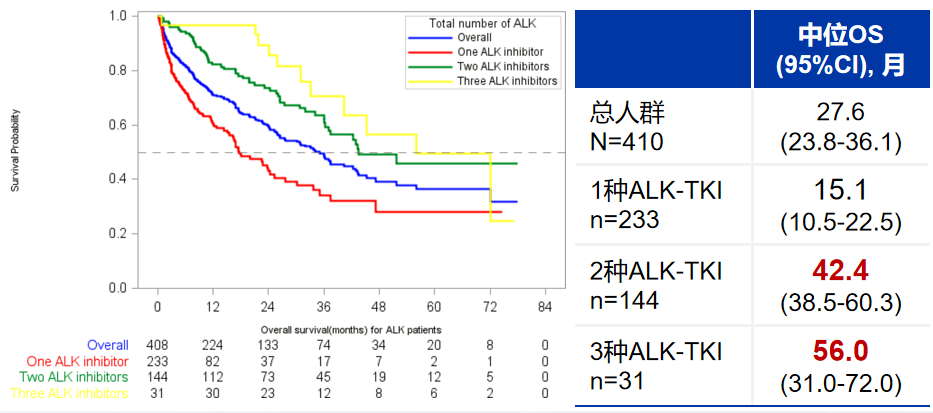Properly grasping the timing of TKI treatment is the key to achieving the long survival of ALK -positive lung cancer!
Author:Cancer Channel of the Medical Time:2022.08.31
*For medical professionals for reading reference

The use of normative sequential treatment, the timing of conversion of TKI is a key point
ALK fusion is among the best in the treatment targets of non -small cell lung cancer (NSCLC). This is mainly because of the clinical of the TKI -type targeted drugs (TKI) targeting drugs (TKI). Essence At present, patients who have exceeded 5 years of total survival (OS) have found every clinical practice. Patients with other ALK-TKI in the first line using clipininib therapy and sequentially use other ALK-TKI. The median OS in real world research can reach 7 years [1-4]. For late NSCLC, this effect is very good, and the goal of transforming Alk -positive NSCLC into a "chronic disease" is achieved.
However, in order to obtain long-term survival, the targeted therapy of ALK-positive NSCLC also needs to be continuously standardized and optimized. For example, in the first-line treatment mode of Kizotininib, it is necessary to accurately judge the indications and timing of different Alk-TKI, so as to do their best It may extend the duration of the treatment of each ALK-TKI and maximize the treatment value of targeted drugs. This article will analyze this issue.
What is the significance of reasonable preface treatment for ALK -positive NSCLC?
In terms of definition, preface treatment refers to the use of different drugs or intervention measures in order, and its main purpose is to maximize the benefit of patient survival. Especially for patients with advanced cancer, OS is still the "gold standard" that judges clinical benefits. If reasonable sequential treatment can reach the longest OS, it will undoubtedly become a treatment model favored by doctors and patients. In the treatment of late NSCLC, the drugs and solutions that can be used for sequential therapy are also very rich (Figure 1).

FIG
At present, when systemic drug treatment of advanced NSCLC, traditional chemotherapy, targeted therapy for driving genes, antemicia production therapy, and immunotherapy all have their own appropriate application scenarios and beneficiaries. Therefore "It looks particularly important. ALK-positive NSCLC is a typical beneficiary group of targeted therapy. In clinical practice, ALK-TKI is often applied to ALK-TKI. Alk-TKI is currently "three generations of the same hall". Many possibilities, and preface therapy is also clearly of the significance of extending the survival of patients.
A real-world retrospective study shows that among the ALK-positive NSCLC patients treated in the first-generation/second-generation Alk-TKI treatment, 3-4 different Alk-TKI patients can treat patients with median OS for 56 months, and 2 The median OS for the treatment of TKI for patients is 42 months, while only one type of TKI is used for the median OS for patients with only 15 months (Figure 2). This reflects that patients with conditions are treated, then ALK-TKI sequential treatment has good clinical value, and the most common preface treatment model in this study is the first-line treatment of Kizyininib (Occupy therapy treatment therapy 60%of the patient) [5].

Figure 2. A variety of Alk-TKI sequential use, which has more clear clinical benefits
With the continuous development of targeted therapy, in many real world studies reported in recent recently, the first-line treatment of Kraminib can make the median OS of patients exceed 7 years [1-4]. However, the important prerequisite to fully realize the benefit of this sequential treatment model is to accurately grasp the timing of sequential therapy, and the most reasonable conversion to the use of different Alk-TKIs.
Adhering to "changing medicine after progress" is the key link of OS to maximize the benefits
As we all know, the conversion treatment drugs for tumor patients usually occur after the progress of the disease, and this conversion often does not affect the patient's non -progressive survival period (PFS). In clinical studies, the sequential treatment converted into other drugs or schemes will not affect the single treatment drug or scheme PFS data evaluated by the institute, but it may have a significant impact on the OS data of the patient [6], and many allowed treatment for treatment This impact in NSCLC clinical studies in Cross-OVER groups.
Choosing a reasonable conversion timing will have a very important impact on the overall benefits of sequential therapy: if the treatment drugs are replaced without the progress of the disease, and the original treatment drugs are not available. It is also shortened by all exertion and the overall treatment duration; after the treatment of the treatment, the drug tolerance mechanism and the use of the appropriate back -line therapy drugs are relatively more reasonable choices. It uses "to maximize OS (Figure 3).

Figure 3. The impact of different sequential treatment modes on patient OS
Taking the real world retrospective studies mentioned earlier as an example, multi-factor analysis shows that the ALK-TKI treatment time (DOT) of the first-line applications is long, which is more prominently related to the second-line application ALK-TKI DOT. -TKI's long DOT is also long and significantly related to the three-line ALK-TKI's DOT (both of the P values <0.0001) [5]; and in the management of multiple chronic diseases and patients who need long-term medication, non-medical reasons (that is, lack of lack of The clinical efficacy/relief, side effects, or poor compliance) replacement is often related to the deterioration of clinical ending [7], which is also of reference significance for the treatment of ALK -positive lung cancer. Therefore, in the national and foreign authoritative NSCLC diagnosis and treatment guidelines such as the National Comprehensive Cancer Network (NCCN) and the China Clinical Oncology Society (CSCO), all are recommended to drive gene positive patients after the progress of first -line treatment. The clinical practical experience of the first -line treatment of Kizotinib also proves that changing medicine after progress is a more favorable choice.
The advantages of accurate application and mechanism, so that the first -line therapy of Kazidininib is recognized
At present, there are a number of random comparison clinical research and real world research, which reports in detail the first -line treatment of Kizinib. The actual application model and clinical ending in the clinical clinical clinical clinical. Plide other Alk-TKI treatment. For example, in the J-ALEX study of the first-line treatment of ALK-positive NSCLC patients in the first-line treatment of ALK-positive NSCLC in the first line, the median time from randomized groups to the first replacement treatment was 12.3 months. The mid -position PFS is longer (10.2 months), indicating that the time node of the replacement of the treatment plan is after the progress of the disease [8].
The final OS analysis of Alex also showed that the 5 -year survival rate of the Kizinib group reached 64.11%, which is equivalent to the Alaidinini group (60.85%), which reflects the sequence therapy for the advancement of the medicine after the first line of the Kizotinib. Model has a clear value of longevity. The earlier Profile 1014 studies [9] and the real world of France [2] also changed the medicine for the first -line treatment of Kizotinib, and the patients reflected clear long -term survival. Among them, the median OS of the real world of France has exceeded 7 years, and the emergence of the three generations of Alk-TKI Lolantinib is expected to further expand the survival benefit of the catentinib sequential treatment [10].
The good benefits of the first -line treatment of Kizyininini are also inseparable from the mechanism and treatment mechanism of Kizotinib itself. Cizetinib is used for the first-line treatment of ALK-positive NSCLC, and the classic EML4-ALK fusion (mainly V1/V3 variants), a variety of non-classic ALK fusion, and alk complex fusion are effective (Figure 4); In the treatment mechanism of dioib, ALK amplification and mutation resistance can be solved by the second/third-generation ALK-TKI. TKI preface treatment provides more opportunities.
Figure 4. Kazininib is effective for classic EML4-ALK fusion, various non-classic ALK fusion, and alk complex fusion

summary
The significant clinical benefits of the first -line treatment model of Kizotinib have been fully confirmed by clinical research and real -world experience. It has successfully established a new benchmark for 7 -year -old survival for Alk's positive NSCLC, and the continuous development of targeted drugs has been developed. It is also expected to further extend the survival. However, in order to maximize the treatment of patients, clinical workers need to be treated reasonably and standardized for sequential treatment, using disease progress as the timing of sequential therapy, and based on dynamic gene test results and the actual condition of the patient, choose the most suitable preface Pin therapeutic drugs can help patients achieve longer and more quality survival.
references:
[1].Pacheco J M, Gao D, Smith D, et al. Natural history and factors associated with overall survival in stage IV ALK-rearranged non–small cell lung cancer[J]. Journal of Thoracic Oncology, 2019, 14(4 ): 691-700.
[2].Duruisseaux M, Besse B, Cadranel J, et al. Overall survival with crizotinib and next-generation ALK inhibitors in ALK-positive non-small-cell lung cancer (IFCT-1302 CLINALK): a French nationwide cohort retrospective study [J]. Oncotarget, 2017, 8 (13): 21903-21917.
[3].Ito K, Yamanaka T, Hayashi H, et al. Sequential therapy of crizotinib followed by alectinib for non-small cell lung cancer harbouring anaplastic lymphoma kinase rearrangement (WJOG9516L): a multicenter retrospective cohort study[J]. European Journal of Cancer, 2021, 145: 183-193. [4] .peled n, Gillis R, Kilickap S, et al. Glass: Global Lorlatinib for Alk (+) and ROS1 (+) Retrospective Study: Real World Data OF 123 NSCLC Patients [j]. LUNG CANCER, 2020, 148: 48-54.
[5].Waterhouse D M, Espirito J L, Chioda M D, et al. Retrospective Observational Study of ALK-Inhibitor Therapy Sequencing and Outcomes in Patients with ALK-Positive Non-small Cell Lung Cancer[J]. Drugs-Real World Outcomes, 2020 , 7 (4): 261-269.
[6] .latimer N R. Treatment Switching in onCology Trials and the Acceptability of Adjustment Methods [J]. Expert Review of PharmacoEconomics Outcomes Research, 2015 (4) 561: 561: 561: 561: 561: 561: 561: 561: 561: 561: 561: 561: 561: 561: 561: 561: 561: 561: 561: 561: 561: 561: 561: 561: 561: 561: 561: 561: 561: 561: 561:
[7].Nguyen E, Weeda E R, Sobieraj D M, et al. Impact of non-medical switching on clinical and economic outcomes, resource utilization and medication-taking behavior: a systematic literature review[J]. Current Medical Research and Opinion, 2016, 32 (7): 1281-1290.
[8].Hotta K, Hida T, Nokihara H, et al. Final overall survival analysis from the phase III J-ALEX study of alectinib versus crizotinib in ALK inhibitor-naïve Japanese patients with ALK-positive non-small-cell lung cancer [J]. ESMO Open, 2022, 7 (4): 100527.
[9] .solomon b j, mok T, kim d w, et al. FIRST-LINE CRIZOTINIB Versus Chemotherapy in Alk-POSITIVE LUNG CANCER [J]. The New England Journal of Medicine, 2014, 371 (23): 2167-211111172111172111172111172111172111172111172111721117211172111721117211172111721117211172111721117211721
: 1788-1794.*This article is only used to provide scientific information to medical people, and does not represent the viewpoint of this platform


- END -
Shanghai Jinshan: "Ningxin Station" helps consumer dispute resolution

Recently, the consumer rights protection psychological counseling room of the Ning...
Medium -intensity exercise, pay attention to monitoring heart rate: Don't let "fitness" "hurt the body"

Practicing yoga to practice lumbar disc herniation walking tens of thousands of st...